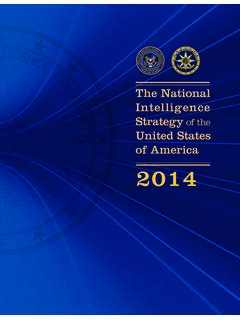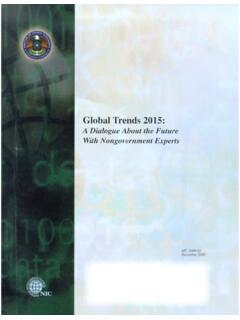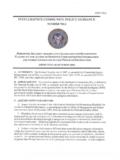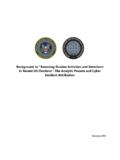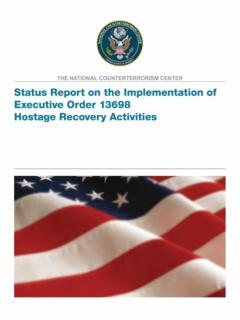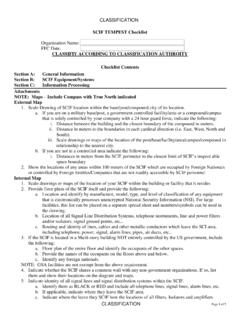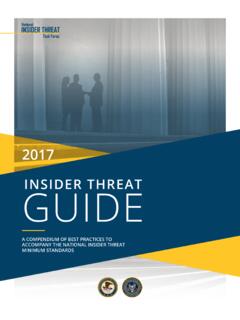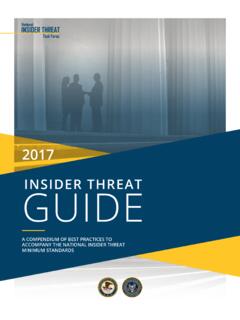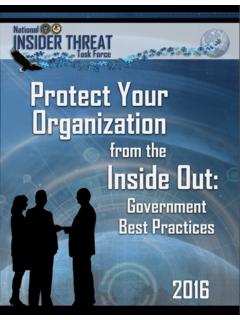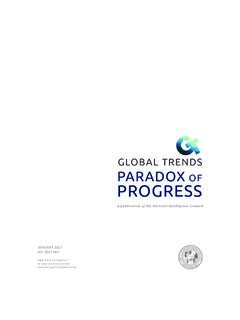Transcription of Foreign Economic Espionage in Cyberspace
1 NATIONAL COUNTERINTELLIGENCE AND SECURITY CENTERF oreign Economic Espionage in Cyberspace2018 ContentsExecutive Summary 1 Scope Note 2 I. The Strategic Threat of Cyber Economic Espionage 4II. Threats from Foreign Countries 5 China: Persistent Cyber Activities 5 Russia: A Sophisticated Adversary 8 Iran: An Increasing Cyber Threat 9 Targeted Technologies 11 III. Emerging Threats 12 Software Supply Chain Operations 13 Foreign Laws Could Enable Intellectual Property Theft 13 Foreign Technology Companies With Links to Host Governments 14 Annex Decreasing the Prevalence of Economic or Industrial Espionage in Cyberspace 151 Executive SummaryIn the 2011 report to Congress on Foreign Spies Stealing Economic Secrets in Cyberspace , the Office of the National Counterintelligence Executive provided a baseline assessment of the many dangers facing the research, development, and manufacturing sectors when operating in Cyberspace , the pervasive threats posed by Foreign intelligence services and other threat actors, and the industries and technologies most likely at risk of Espionage .
2 The 2018 report provides additional insight into the most pervasive nation-state threats, and it includes a detailed breakout of the industrial sectors and technologies judged to be of highest interest to threat actors. It also discusses several potentially disruptive threat trends that warrant close report focuses on the following issuesForeign Economic and industrial Espionage against the United States continues to represent a significant threat to America s prosperity, security, and competitive advantage. Cyberspace remains a preferred operational domain for a wide range of industrial Espionage threat actors, from adversarial nation-states, to commercial enterprises operating under state influence, to sponsored activities conducted by proxy hacker groups. Next-generation technologies, such as Artificial Intelligence (AI) and the Internet-of-Things (IoT) will introduce new vulnerabilities to networks for which the cybersecu-rity community remains largely unprepared.
3 Building an effective response will require understanding Economic Espionage as a worldwide, multi-vector threat to the integrity of the economy and global intelligence services and threat actors working on their behalf continue to represent the most persistent and pervasive cyber intelligence threat. China, Russia, and Iran stand out as three of the most capable and active cyber actors tied to Economic Espionage and the potential theft of trade secrets and proprietary information. Countries with closer ties to the United States also have con-ducted cyber Espionage to obtain technology. Despite advances in cybersecurity, cyber espio-nage continues to offer threat actors a relatively low-cost, high-yield avenue of approach to a wide spectrum of intellectual range of potentially disruptive threat trends warrant attention. Software supply chain infiltration already threatens the critical infrastructure sector and is poised to threaten other sectors.
4 Meanwhile, new Foreign laws and increased risks posed by Foreign technology companies due to their ties to host gov-ernments, may present companies with previously unforeseen threats. Cyber Economic Espionage is but one facet of the much larger, global Economic Espionage challenge. We look forward to engaging in the larger public discourse on mitigating the national Economic harm caused by these NoteThis report is submitted in compliance with the National Defense Authorization Act for Fiscal Year 2015, Section 1637, which requires that the President annually submit to Congress a report on Foreign Economic Espionage and industrial Espionage in Cyberspace during the 12-month period preceding the submission of the of Key Terms For the purpose of this report, key terms were defined according to definitions provided in Section 1637 of the National Defense Authorization Act for Fiscal Year or Industrial Espionage means (a)
5 Stealing a trade secret or proprietary information or appropriating, taking, carrying away, or concealing, or by fraud, artifice, or deception obtaining, a trade secret or proprietary information without the authorization of the owner of the trade secret or proprietary information; (b) copying, duplicating, downloading, uploading, destroying, transmitting, delivering, sending, communicating, or conveying a trade secret or proprietary information with-out the authorization of the owner of the trade secret or proprietary information; or (c) knowingly receiving, buying, or possessing a trade secret or proprietary information that has been stolen or appropriated, obtained, or converted without the authorization of the owner of the trade secret or proprietary means (a) the interdependent network of information technology infrastructures ; and (b) includes the Internet, telecommunications networks, computer systems, and embedded processors and National Counterintelligence and Security Center (NCSC) compiled this report, with close sup-port from the Cyber Threat Intelligence Integration Center (CTIIC), and with input and coordination from many Government organizations, including the Central Intelligence Agency (CIA), Defense Cyber Crime Center (DC3), Defense Intelligence Agency (DIA), Defense Security Service (DSS), Department of Energy (DoE), Department of Defense (DoD), Department of Homeland Security (DHS), Department of State (DoS), Department of Treasury (Treasury), Federal Bureau of Investiga-tion (FBI), National Cyber Investigative Joint Task Force (NCIJTF), National Geospatial-Intelligence Agency (NGA), National Reconnaissance Office (NRO), National Security Agency (NSA)
6 , and Office of the Director of National Intelligence (ODNI).34I. The Strategic Threat of Cyber Economic EspionageForeign Economic and industrial Espionage against the United States continues to represent a significant threat to America s prosperity, security, and competitive advantage. Cyberspace remains a preferred operational domain for a wide range of industrial Espionage threat actors, from adversarial nation-states, to commercial enterprises operating under state influence, to sponsored activities conducted by proxy hacker groups. Next-generation technologies such as Artificial Intelligence (AI) and the Internet-of-Things (IoT) will introduce new vulnerabilities to networks for which the cybersecurity community remains largely unprepared. Building an effective response demands understanding Economic Espionage as a worldwide, multi-vector threat to the integrity of the economy and global United States remains a global center for research, development, and innovation across multiple high-technology sectors.
7 Federal research institutions, universities, and corporations are regularly targeted by online actors seeking all manner of proprietary information and the overall long-term trend remains next generation technologies will introduce a range of qualitative advances in data storage, analytics, and computational capacity, they also present potential vulnerabilities for which the cybersecurity community remains largely unprepared. The solidification of cloud computing over the past decade as a global information industry standard, coupled with the deployment of technologies such as AI and IoT, will introduce unforeseen vulnerabilities to networks. Cloud networks and IoT infrastructure are rapidly expanding the global online operational space. Threat actors have already demonstrated how cloud can be used as a platform for cyber exploitation. As IoT and AI applications expand to empower everything from smart homes to smart cities , billions of potentially unsecured network nodes will create an incalculably larger exploitation space for cyber threat actors.
8 Lack of industry standardization during this pivotal first-generation deployment period will likely hamper the development of comprehensive security solutions in the near-term. Building an effective response demands understanding Economic Espionage as a worldwide, multi-vector threat to the integrity of both the economy and global trade. Whereas Cyberspace is a preferred operational domain for Economic Espionage , it is but one of many. Sophisticated threat actors, such as adversarial nation-states, combine cyber exploitation with supply chain operations, human recruitment, and the acquisition of knowledge by Foreign students in universities, as part of a strategic technology acquisition Threats from Foreign Countries Foreign intelligence services and threat actors working on their behalf continue to represent the most persistent and pervasive cyber intelligence threat. China, Russia, and Iran stand out as three of the most capable and active cyber actors tied to Economic Espionage and the potential theft of trade secrets and proprietary information.
9 Countries with closer ties to the United States have also conducted cyber Espionage to obtain technology. Despite advances in cybersecurity, cyber Espionage continues to offer threat actors a relatively low-cost, high-yield avenue of approach to a wide spectrum of intellectual anticipate that China, Russia, and Iran will remain aggressive and capable collectors of sensitive Economic information and technologies, particularly in Cyberspace . All will almost certainly continue to deploy significant resources and a wide array of tactics to acquire intellectual property and proprietary with closer ties to the United States have conducted cyber Espionage and other forms of intelligence collection to obtain technology, intellectual property, trade secrets, and proprietary information. allies or partners often take advantage of the access they enjoy to collect sensitive military and civilian technologies and to acquire know-how in priority : Persistent Cyber ActivitiesChina has expansive efforts in place to acquire technology to include sensitive trade secrets and proprietary information.
10 It continues to use cyber Espionage to support its strategic development goals science and technology advancement, military modernization, and Economic policy objectives. China's Cyberspace operations are part of a complex, multipronged technology development strategy that uses licit and illicit methods to achieve its goals. Chinese companies and individuals often acquire technology for commercial and scientific purposes. At the same time, the Chinese government seeks to enhance its collection of technology by enlisting the support of a broad range of actors spread throughout its government and industrial OFFICIAL USE ONLYUNCLASSIFIED//FOR OFFICIAL USE ONLYUNCLASSIFIED//FOR OFFICIAL USE ONLYNon-Traditional CollectorsChina uses individuals for whom science or business is their primary profession to target and acquire US Ventures (JV)China uses JVs to acquire technology and technical partnershipsChina actively seeks partnerships with government laboratories-such as the Department of Energy labs-to learn about and acquire specific technology, and the soft skills necessary to run such CollaborationsChina uses collaborations and relationships with universities to acquire specific research and gain access to high-end research equipment.
